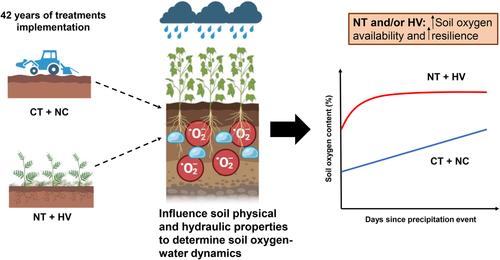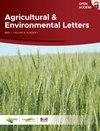Forty-two years of no-tillage and cover cropping improved soil oxygen availability and resilience
Abstract
Healthy soil air–water balance is critical for crop growth. Conservation agricultural practices improve soil physical properties to influence soil oxygen availability. We evaluated the impact of 42 years of hairy vetch (HV) cover cropping (CC), and no-tillage (NT) on soil oxygen dynamics during a cotton growing season experiencing multiple intensive rain events in silt loam soil. The HV and NT treatments exhibited higher growing season soil oxygen availability (p < 0.05) and experienced three to four times fewer hours of oxygen limitation (i.e., oxygen concentration <10%) as compared to no cover crop (NC) and conventional tillage (CT) treatments. After a heavy rainfall, NT–HV treatment exhibited the highest soil oxygen availability, followed by NT–NC, CT–HV, and CT–NC treatments (p < 0.05). While CC and/or NT treatments quickly regained soil oxygen status within 24 h after saturating rain events, CT–NC suffered from sub-optimal soil aeration until the third day after rainfall cessation. The combination of CC with NT practices enhanced soil oxygen availability and resilience to extreme precipitation events.
Core Ideas
- Long-term cover cropping and no-tillage practices enhanced soil oxygen availability following extreme precipitation events.
- Cover cropping and no-tillage practices reduced the duration of anoxia experienced by cotton crops during the growing season by three- to four-fold.
- Combined cover cropping and no-tillage implementation exhibited the most significant impact in mitigating immediate soil oxygen stress after heavy rainfall events.



 求助内容:
求助内容: 应助结果提醒方式:
应助结果提醒方式:


